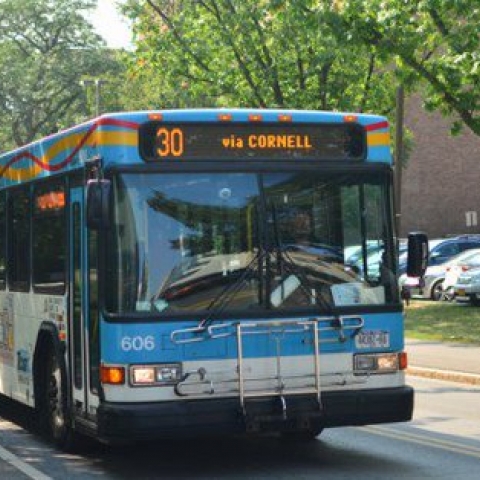
Cornell Daily Sun | Katherine Heaney, May 1, 20
Trying to figure out how to use the TCAT bus system is a struggle for many members of the Cornell and Ithaca community. Now, students and locals alike can turn to Ithaca Transit, an app designed by Cornell students, to help them navigate Ithaca by bus more easily.
Team member and iOS developer for Ithaca Transit Monica Ong ’19 explained that Ride14850, a “go-to app” for students to determine their ideal bus routes “still has, a terrible [user interface].”
“I remember when I first started using it as a freshman, I had to figure out how to put in starting and ending locations and then I had to figure out how to read the results to figure which bus I needed to take,” she said.
“Ithaca Transit is an end-to-end navigation solution that combines the best transit features available into one app,” said project lead Matt Barker ’19. “While apps like Ride14850 only provide routing on a clunky interface or MyStop only provides live updates, Ithaca Transit includes the best features to ride smarter and get you where you need to go.
“Combining live tracking and updates with Google Maps and Search integration, Ithaca Transit is a free and simple solution for the entire transit process,” he added.
The app was created by Cornell AppDev, a project team at Cornell that designs, develops and distributes mobile and web applications through the App Store. It previously developed “Eatery,” a popular app amongst Cornell students that allows them look up the daily hours and menus for Cornell’s dining locations.
Ithaca Transit currently has over 1000 users and 300 active daily users, according to the Cornell AppDev team and can be downloaded for free from the App Store.
Prominent features of the app include live TCAT bus tracking and updates so users can track bus locations and receive notifications when the bus arrives at their stop.
“We want to bring real-time notifications to the app,” said Austin Astorga ’19, a member of Cornell AppDev and an iOS developer for Ithaca Transit. “These notifications would tell you when your bus is arriving, when to get off the bus, and other information riders will find useful.”
Cornell AppDev had received several requests to create a TCAT bus app for Ithaca. Students were frustrated with trying to read the PDF files on TCAT’s website, or having to pay for unreliable apps.
Citing the “overwhelming” quantity of route numbers and stop names, Mihir Chauhan ’18, Cornell AppDev member and one of Ithaca Transit’s first designers, recalled that since his freshman year, he had witnessed many of the students’ complications as a result of inadequate, existing apps.
“Students wait out in the cold wondering when the bus is coming or if it already left, and often are unsure if they’re even on the right bus,” he said.
Chauhan said that they approached this obstacle with the reasoning that, “if a freshman who doesn’t know Ithaca at all can figure it out, anyone can.”
“So we started out by designing for the clueless freshman, but also added features like ‘Favorites’ for people more familiar with the area who’ve used the same stops for years,” he said.
App developers consulted locals and Cornell students to learn about their TCAT experiences in order to create a platform “designed specifically with Ithaca in mind,” Chauhan said.
Users can use Ithaca Transit for travel to any location within Ithaca and can also “favorite” their frequent destinations, which saves these locations to their home page for future convenience.
Users can even locate their correct destination by searching precise addresses or even something Chipotle, Chauhan explained.
“A recurring struggle we heard from users of other apps was having to know exactly what bus stops exist when they search,” he said.
The app also uses Google Maps and Search to optimize bus routes. Users can search for any location and the app will display all of the TCAT bus transfer options as well as walking directions from the nearest TCAT stop to the desired location.
“One of the biggest challenges was being able to deliver accurate and great bus route options,” Astorga said. “Delivering great routes is a lot harder than what people might think,” but the team now has a creation with routing techniques that rival providers like Google Maps, according to Astorga.
Ong said that the team is “proud of where Ithaca Transit has gotten today,” but that this is “only the beginning,” and the team plans to add and improve the app’s features and extend its target audience to users who do not have iPhones.
“Our plan is to get feedback from the community and users,” Chauhan said. “We want to solve as many of their problems as possible. We’re looking to modify existing features and add new ones based on the feedback we get.”
